Composting toilets and city flats: do they match?
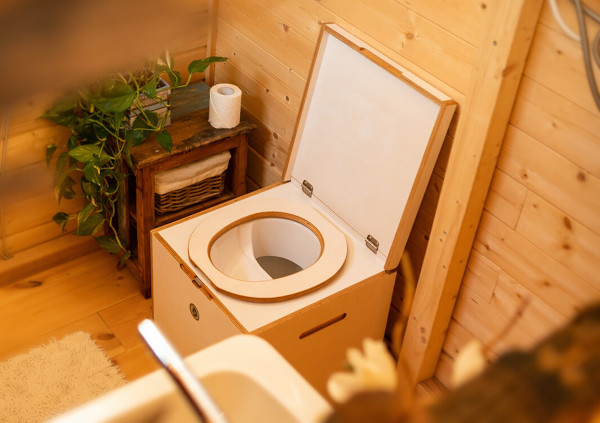
Composting toilets are a great choice for low-impact living — for remote or off-grid homes, for self-contained homes, for boats, for camper vans. That much is certain. But is the ‘revolootion’ possible if you’re renting out a flat? With no garden, no plot of land to call your own, does a composting toilet make any sense?
WHAT’S ‘LOW IMPACT’ ABOUT DRY TOILETS (AKA COMPOSTING TOILETS AKA SOURCE SEPARATION TOILET)
If you’re new to the concept of a composting toilet, here’s a comprehensive introduction to the topic.
The impact of a source separation or dry toilet is twofold — no pun intended. There is a slew of individual benefits and there is a systemic effect. Obviously, there are downsides, too.
Now, when we say individual benefits, we think:
- a sustainable, more holistic approach to sanitation (‘humanure’, liquid fertilizer)
- saving drinking water
- a higher level of residential independence (mobile homes)
- aerobic composting means no greenhouse gas emissions
The downside of using a dry toilet is mainly rooted in the convenience and the established perception of its flush counterpart as the only right way. When you’re new to the source separation concept, you’re facing taboo matters. This may not be easy for everyone.
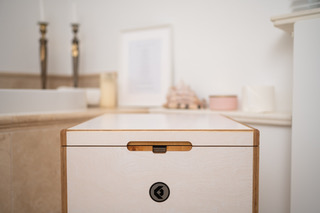
Another downer is that the flush toilet system, as flawed as it may be, is a well-regulated one. Sanitation must remain, well, sanitary. While people still happen to send things down the drain that shouldn’t go there, for the most part of the population, the use of a flushing toilet is a no-brainer.
But when it comes to the disposal of the waste collected in a dry toilet unit, regulations are all over the place. Depending on where you live, the use of fertilizers obtained through composting can be heavily restricted (and for good reasons — potential drinking water contamination being one of them). Most of the population aren’t even used to dry toilets or haven’t heard of them before. Even ‘vanlifers’ can experience shocked camping personnel, mistaking the composting toilet contents for chemical toilet waste.
On the systemic level, there have been projects and tests that tried and implemented composting toilets in blocks of flats. The results? More than just a reduction in blackwater and sewage sludge; saving drinking water and taking the proverbial load off the local sewer system were also among the reported effects.
Still, composting (or dry, or source separation) toilets can’t fully replace water toilets just yet.
So, with all that said: are there any good reasons to have a dry toilet in a city flat?

We’ve come up with 5 pretty neat ideas.
1. EMERGENCY PREPAREDNESS
As climate change progresses, extreme weather conditions are on the rise. Even residents of areas unaffected by tornadoes or floods can experience severe problems and are advised to get prepared for emergencies. One of the most likely emergency scenarios in an urban setting is a power outage. A power outage of just a few hours can have an impact of up to days and even weeks — when it comes to restoring communications, drinking water and food supply, and, yes, the sanitation of a large city or an urban area.
Official guidance suggests having emergency kits ready as well as at least three days’ supply of drinking water and ready-to-eat food.
So a compact, portable ‘backup’ sanitation solution is what we like to see added to emergency gear.
2. SAVING DRINKING WATER
When we seek ways to introduce more low-impact habits, saving drinking water comes to mind almost instantly.
The very idea of flush toilets operating on drinking water seems extravagant to say the least.
But in a flat, even if you don’t own a garden to really benefit from ‘humanure’ or the liquid fertilizer, you can effectively reduce the amount of flushing water. Remember: the water that operates our conventional toilets is drinking water that quite literally goes down the drain several times a day.
In a flat scenario, flushing the collected liquids into your conventional toilet every few days and disposing of the solids (dried, stink-free and tightly wrapped in a bio-degradable bag!) in the household waste will reduce the usage of drinking water dramatically.
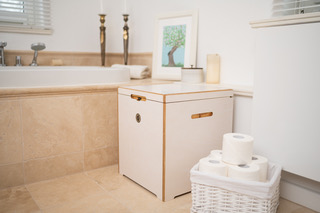
3. ENJOY THE GREAT OUTDOORS
Testing a dry toilet in your van or taking the toilet on a hiking, camping or biking tour doesn’t technically count as using it in your city flat. But it’s a good introduction and a nice acid test — also pretty helpful to master the art of the dry toilet, too!
And since many dry toilets are designed to remain portable, having one in your flat that you can move around or pack for a road trip is giving you plenty of options.
4. RUBBISH IN, RUBBISH OUT
Consider this: conventional toilets are ‘out of sight, out of mind’ units. As long as you’re keeping the seat and the bowl shiny and clean, whatever leaves your body, slips your mind.
When people are relying on a dry toilet, the waste becomes a more… vital issue. ‘What did I eat to produce this?!’ one might exclaim, which often can lead to rethinking dietary and lifestyle habits.
Now, are we saying dry toilets will make you healthier? No.
What we are saying though is: awareness for our body’s needs can rise once waste can’t be simply ‘undone’ and unseen by flushing.
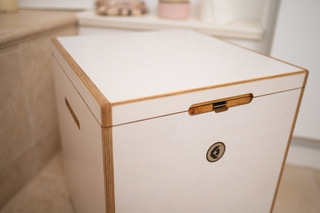
5. MORE DESIGN OPTIONS
A toilet is a toilet is a toilet — in terms of functionality, or in terms of design, not much to tweak there. Right?
Well, when it comes to a composting toilet (either a DIY version, or a wooden one like the Kildwick FancyLoo that easily doubles as an inconspicuous seat), you can get plenty of options to create a design to match all and any of your aesthetic needs.
So what do you think? How will sanitation evolve for a low-impact future? What options do you see for urban living? Tell us in the comments.
The views expressed in our blog are those of the author and not necessarily lowimpact.org's
6 Comments
-
1Daniel Scharf August 26th, 2021
I the Solent area of Hampshire housebuilding has been stopped due to nitrate pollution. Last year Defra tried to help.”Housing growth has stalled in the Solent area for over a year due to concerns that nitrates were causing a range of negative environmental effects. These include excessive growth of green algae which smothers and damages rare habitats and wildlife, including the Solent’s internationally protected estuaries, salt marshes and seagrass beds, as well as protected birds including curlews.”. Compost toilets could be another answer if housebuilders thought that these could be sold?
-
2Malcolm August 26th, 2021
My wife and I experimented with a compost loo in our conventional bathroom this year. We used a plastic bin with a home made wooden seat and lid. We were amazed at how easy it all was and were surprised at the lack of smell (we used a sawdust soak), less smell than a conventional loo. We emptied it 1 or 2 times a week and that was also surprisingly easy and hazard free, much to our surprise. Would thoroughly recommend it.
-
3Andrew Rollinson August 27th, 2021
Dear Michelle,
The problem here, if you live in a flat as you say “with no garden [and] no plot of land”, is where do you empty the toilet? This is not mentioned in the blog, nor can I see anything on the Kildwick website. The toilets on the Kildwick site are not big enough to compost the solid waste in-situ, and to a lesser extent there is also the issue of where to put the liquid waste.
I am in favour of dry toilets, and now only have such systems where I live. But people must be aware of the practicalities..
For solids, you either need a large. ca. 1m3 per user composting area below the toilet and two of these to alternate. This is unlikely to be practical in a flat and it still leaves the issue of urine disposal. Or they will need to dispose of the solid at very frequent intervals. For a toilet such as the one shown, and a flat of two people, expect emptying a large sack of un-decomposed faeces at least twice per week. This will mean carrying it out of the flat and ideally burying it in the soil somewhere nearby or having some large sealed compost bins to put it in. This gets very tedious.
It is, I think, misleading to not make this clear on your blog and website Michelle.
Andrew
-
4Dave Darby August 27th, 2021
Daniel – I wonder if they could be sold if the local authority sent around trucks to empty them?
Malcolm – yes, I’ve seen very effective, simple solutions, like this one: https://www.lowimpact.org/the-simplest-diy-compost-toilet/
Andrew – good point. I’ll try to get Michelle to respond.
[actually, she does say: In a flat scenario, flushing the collected liquids into your conventional toilet every few days and disposing of the solids (dried, stink-free and tightly wrapped in a bio-degradable bag!) in the household waste]
(don’t know what the local authority would make of that, but I don’t see that it would be a major problem, unless thousands of people were doing it, which they wouldn’t be? It would go back to the soil eventually – just taking the long route)
-
5Aimee July 9th, 2022
The problem with a composting toilet in the city is that people have to bag up their ‘solids’ and put them in the garbage, which takes it to a landfill that is anaerobic and therefore doesn’t break down, as curbside composting will not take humanure, even if it’s zero-smell like the Natures Head one that has you mix it with coir. We had a NH composting toilet on our farm and loved it because 1) the pee could be poured around the perimeter of our veggie garden fence which was a free way of keeping the deer out since we didn’t have a 6′ fence around it – not one deer in 4 years! and 2) we could easily bury the zero-stink solids on the back of the property. Plus we vented it through a rigid pipe through the roof, a step above what the manufacturer provides for tiny homes, since our house was larger. Everyone else with these for is throwing their poo in the trash which is not saving the planet one bit, as they are trading water use for landfill use, yet still patting themselves on the back. Advocating for city composting programs to take humanure from composting toilets would not only help this but get more folks to use this type of system. Now that we are back in the city, we switched all our toilets with dual-flush as well as stick to the yellow/mellow philosophy with the liquids…but really miss our composting toilet. Ironically, it was hard to explain to folks when we were selling our house as even though it was marketed with zillions of sustainability features, many wanted to yank out this $900 toilet and replace it with a wasteful water-based one. 🙁
-
6Dave Darby July 10th, 2022
Aimee – yes, I think compost loos work well when you have land / space to compost further and to use the finished compost. This could work in town houses, but would be difficult in flats. I think compost loos will only work well in cities when local authorities send round collection trucks, take the waste to further composting facilities, and then on to farms.




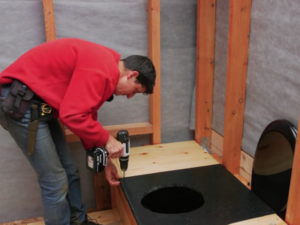 Our new compost toilets online course is live – and we think you’ll love it!
Our new compost toilets online course is live – and we think you’ll love it!
 Why flushing away ‘waste’ water is a bad idea, and what better options exist
Why flushing away ‘waste’ water is a bad idea, and what better options exist
 In praise of the compost toilet: why I love compost loos
In praise of the compost toilet: why I love compost loos
 Bokashi composting: A beginners guide to slimming down your black bin waste
Bokashi composting: A beginners guide to slimming down your black bin waste
 Using compost as mulch
Using compost as mulch
 Compost toilets
Compost toilets
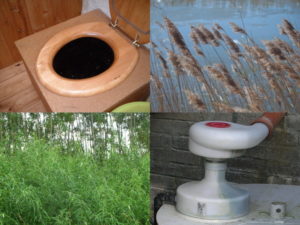 Low-impact sewage treatment
Low-impact sewage treatment


